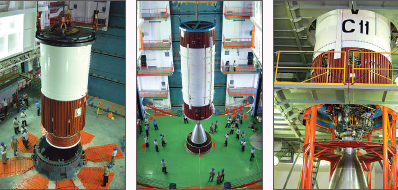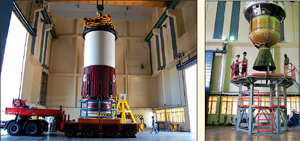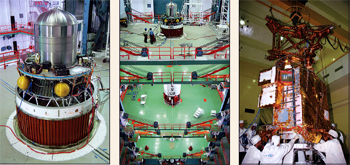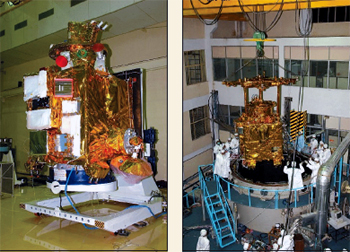|
Bangalore. In what has been perceived
to be a setback to the Indian space programme,
the country's maiden lunar probe Chandrayan-1
has been hit by a snag following the failure of
its vital star sensor on April 26.
The loss of the star sensor meant to determine
the orientation and position of this lunar orbiter,
is known to have been caused by overheating the
excessive solar radiation.
However ISRO (Indian Space Research Organisation)
has been able to overcome this malfunctionpartly
by activating the redundant onboard gyroscopes.
In order to conserve the onboard fuel required
for orbital maneuvers, on May 19, ISRO also raised
the orbit of Chandrayaan-1 to 200 km from 100-km.
In the higher orbit, a spacecraft is known to
be less prone to the degrading effects of the
space environment.
According to a press note issued by ISRO, “other
than the failure of the star sensor and one of
the bus management units, health of the spacecraft
is normal.”
 The
loss of one of the bus management units means
that Chandrayaan-1 is running on the backup unit.
All said and done, the use of gyroscopes along
with the antenna information and images of specific
location of the lunar surface for determining
its orientation is considered a far from safe
option. Being an electro mechanical device, gyroscopes
are considered far more vulnerable to the environmental
rigors of outer space in comparison to the star
sensor. The
loss of one of the bus management units means
that Chandrayaan-1 is running on the backup unit.
All said and done, the use of gyroscopes along
with the antenna information and images of specific
location of the lunar surface for determining
its orientation is considered a far from safe
option. Being an electro mechanical device, gyroscopes
are considered far more vulnerable to the environmental
rigors of outer space in comparison to the star
sensor.
”One cannot predict failures as it can always
happen. If some more failures happen, then we
have problems,” said ISRO Chairman G Madhavan
Nair.
Dismissing the suggestion that the loss of star
sensor could reduce the lifespan of the Indian
lunar probe, Nair said that the failure though
could affect the performance of Chandrayaan-1.
“The life of the spacecraft is not dependent on
this instrument.”
But to what extent it will affect the various
experiments onboard Chandryaan-1, no one is sure
as yet, he observed.
The Rs 4,000 million Chandrayaan-1 is carrying
six international and five Indian payloads. It
is designed for a lifespan of two years, and was
launched by means of an augmented version of the
fourstage Indian space workhorse, the Polar Satellite
Launch Vehicle (PSLV) on October 22, 2008 from
the Satish Dhawan Space Centre (SDSC) in Sriharikota
island on India’s eastern coast.
 This
achievement catapulted India to the elite league
of space faring nations – USA, Europe, Russia,
China and Japan – which have already sent probes
to earth’s nearest celestial neighbor. This
achievement catapulted India to the elite league
of space faring nations – USA, Europe, Russia,
China and Japan – which have already sent probes
to earth’s nearest celestial neighbor.
The Indian designed and developed MIP (Moon
Impact Probe), weighing over 30-kg and with miniature
Indian flags painted all around, was successfully
ejected from the mother spacecraft for its planned
crash landing on the lunar surface on the night
of Nov 14, 2008.
The Chandrayaan-1 mission, described as the landmark
Indian venture beyond the near earth orbit, had
as its objectives enhancing our knowledge for
the mankind, enhance India’s capability to build
more reliable and efficient launch vehicles and
spacecraft systems particularly through microminiaturization,
and provide opportunities for planetary research
for the younger generation.
The scientific focus of the Chandrayaan-1 mission
has been on preparing a three dimensional map
of the lunar surface showing distribution of chemicals
and minerals in addition to looking for signs
of water and checking for the presence of Helium-3.
i Mr
Madhavan Nair drives home the point that during
the last eight months of its operations, Chandrayaan-1
has helped collect “almost all the data we needed.”
And that most of the misison objectives had been
met. Mr
Madhavan Nair drives home the point that during
the last eight months of its operations, Chandrayaan-1
has helped collect “almost all the data we needed.”
And that most of the misison objectives had been
met.
”We had a meeting with the scientific community
a month back and they have stated that the quality
of data was excellent. We have accomplished 90-95%
of objectives set for the mission,” observed Nair.
A press note issued by ISRO noted that Chandryaan-1
had completed 3,000 orbits around the moon and
has made available more than 70,000 images of
the lunar surface which provided a breathtaking
peep into lunar mountains and craters, especially
craters in the permanently shadowed polar regions
of the moon.
Clearly and apparently, the snag that has hit
Chandrayaan-1 is not an isolated phenomenon or
an uncommon occurrence. For many high profile
lunar probes launched by the leading space faring
nations including the USA, Russia and Japan have
had their share of “troubles and snags”.
Maneuvering a lunar spacecraft and positioning
it around the moon is a very complex operation
that can be jeopardized by several space environmental
factors including excessive radiation and gravitational
deviations.
Interestingly, a third of the moon probes have
met with premature ends while being subjected
to maneuvers for inserting them into lunar orbit.
Moreover, the first nine moon missions had ended
up in failures.
As stated by Nair, “Such failures occur in complex
missions. We did not have any experience of this
kind earlier and we have understood the intricacies
of going round the moon. The data obtained so
far will help us make the subsequent missions
like Chandrayaan-II much more reliable. Our scientists
will have to take care of environmental issues
for the future.”
 Perhaps
the biggest achievement of ISRO is the smooth
and flawless insertion of Chandrayan-1 spacecraft
around the moon after its 3.84 lakh km journey. Perhaps
the biggest achievement of ISRO is the smooth
and flawless insertion of Chandrayan-1 spacecraft
around the moon after its 3.84 lakh km journey.
Mr Nair also made it clear that Chandrayaan-1
sensor failure would not affect the course of
the follow up mission Chandrayaan-II, slated for
launch in 2013.
The Rs. 4250-million Chandrayaan-II is planned
to be launched by means of the three stage Geosynchronous
Satellite Launch Vehicle (GSLV) featuring an upper
cryogenic engine stage.
Unlike Chandrayan-1, Chandrayaan-II will feature
a rover with robotic arms for landing on the lunar
surface to collect samples of rocks and soil.
The soft landing of the lunar probe will be biggest
challenge for India’s second moon mission. As
there is no atmosphere, parachuting is ruled out.
The collected lunar samples will be subjected
to in situ chemical analysis and data transmitted
to the mother spacecraft in lunar orbit. The landing
platform in tandem with the rover will get separated
from the main Chandrayaan-II. Which will be firmly
positioned in the orbit around the moon. Like
Chandrayaan-1, it is also expected to carry international
payloads though they are yet to be finalized.
Russia is a major partner in this venture.
Undeterred by the Chandrayaan-1 sang, ISRO is
determined to forge ahead with its plan to sustain
its Mission Space, for it is the space which holds
the key for the future of humanity.
|